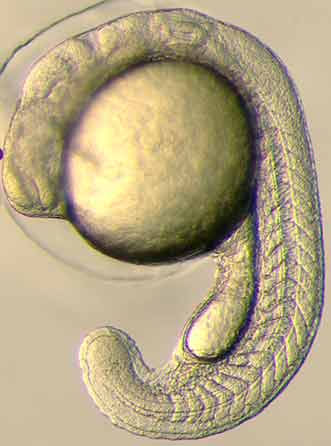The finding, by helping to understand how the heart develops, is a step closer to intervention and is of particular importance if we consider that problems in heart asymmetry are the main cause of heart congenital diseases that can affect as much as 8 out of 1000 newborns. The research appears in a special December issue of the journal Development Dynamics 1 dedicated to left-right asymmetry development.
At first glance, the left and right sides of our bodies are identical to one-another. Inside, however, it is quite a different story and organ asymmetry is believed to improve not only the packaging of the organs, but also their proper functioning. The normal disposition of internal organs and structures, which is conserved within vertebrates, is called situs solitus. Alterations of this state include full mirror-reversal organ disposition- a pathology made famous by news of people stabbed in the heart just to discover that their heart was in fact on the opposite side of the body - or cases where individuals have two right or two left sides. But, despite the fact that most alterations in the normal positioning of human organs originate severe medical conditions, very little is actually known about the events behind this type of development.
As such, to understand them is not only a fundamental question of Developmental Biology but also highly relevant for human health. This is of particular importance with the heart, which is incredible susceptible to any changes in its normal asymmetry, as the high mortality and disease rates in patients with congenital heart defects so clearly demonstrate.
With this in mind Maria Ines Medeiros de Campos-Baptista and Alexander F. Schier from the Institute Gulbenkian of Science (Lisbon, Portugal) and the Harvard University (Cambridge, USA) and colleagues decided to analyse the expression of the Nodal gene family – which has been linked to left-right axis determination in vertebrates - during the development of zebrafish heart.


Zebra fish 24 hours embryo
Genes linked to asymmetric development are active in the embryo very early during development and only on one side and in fact, the researchers found that some Nodal were expressed at the onset of asymmetry, on left side of the embryo and even co-localizing with heart markers supporting the idea that this family was in fact involved in the asymmetric development of the heart.
To investigate this further Campos-Baptista, Schier and colleagues used a powerful 4D microscope technique that allows to follow individual cells, to film, in real time, the heart development of zebrafish embryos that have been modified to express green fluorescent protein (GFP) in their heart muscle cells (or cardiomyocytes). The idea was that with this marker - together with the fact that zebrafish embryos are transparent - it was possible to track of individual cardiomyocytes as the heart developed to determine the importance of Nodal genes in this development.
By comparing animals with or without functional Nodal, the researchers found that these genes regulated the speed and direction of cardiomyocytes, and, when lacking, led to slower and randomly moving cardiomyocytes that losing their asymmetric behaviour, go and form a symmetrically positioned heart (so localised on the body midline).
Nevertheless, although problems in the Nodal genes do affect heart positioning, the fact that this organ is still formed and the organism is viable – although probably not too healthy - reveals that other independent mechanisms, regulated by other genes, affect the same development.
In conclusion, Campos-Baptista, Schier and colleagues’ results show that the movement of individual cardiomyocytes is the determining force behind heart morphogenesis, and that the Nodal genes, by controlling the speed and direction of individual heart muscle cells, are in fact responsible for the asymmetric formation of the heart
“The next step - according to Ines Campos-Baptista, a Portuguese researcher and the first author of the article - will be to identify other genes this time behind the particular movements of the cardiac cells, such as those linked to the cell skeleton, etc. Identifying these will be crucial to fully understand heart asymmetric formation and - since Nodal also plays a role in this developmental of other organs - it will also shed light on the development of many other internal organs such as the pancreas, gut, lungs, etc.”
Campos-Baptista, Schier and colleagues’ findings are important for a better understanding of the mechanism behind embryonic development, specifically of the heart, and, as such, can take us a little closer to one day to be able, not only of preventing heart congenital anomalies, but also of being able to grow our own heart tissues. Although that time is still a long way away.
1 Development Dynamics – Special December issue of the journal Development Dynamics dedicated to left-right asymmetry development, “Nodal signaling promotes the speed and directional movement of cardiomyocytes in zebrafish”





Comments